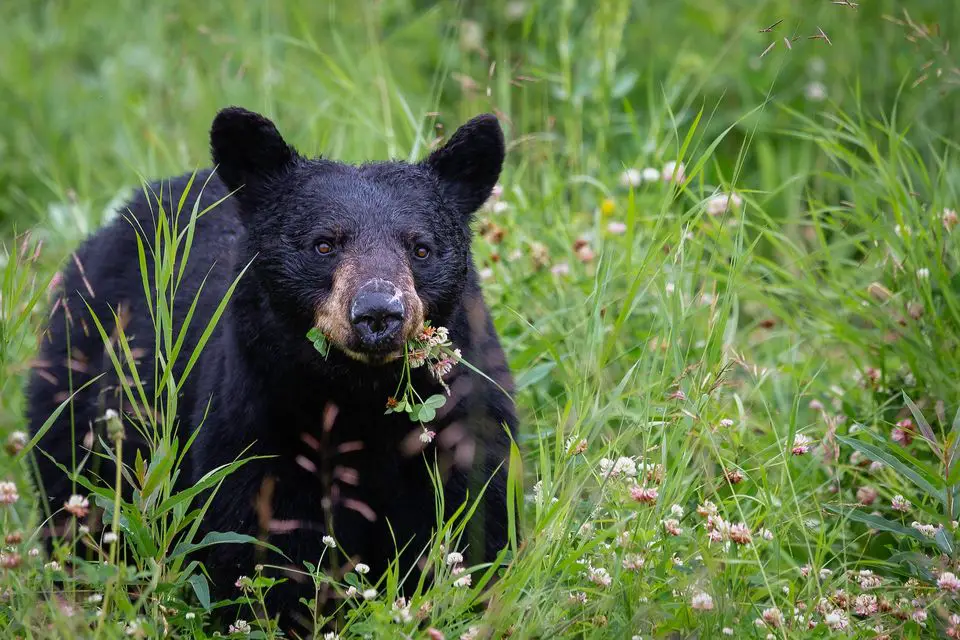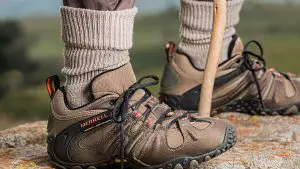What to Do If You See A Black Bear While Hiking?

If you’re hiking in an area where black bears are known to roam, it’s important to know how to behave if you encounter one. Although black bears are considered much less deadly than their counterpart, brown bears can still be dangerous if startled or threatened, so it’s crucial to know how to avoid provoking them and what to do if you come across one on the trail. Read on to find out what to do if you see a black bear while hiking your next trail.
Quick Links
Black Bear vs. Brown Bear
So, let’s distinguish between the two types of bears you might encounter while hiking: black bears and brown bears.
Black bears are found throughout North America, including in every Canadian province except Alberta, while brown bears live in Alaska and parts of western Canada.
Appearance-wise, brown bears are much larger than black bears—an adult male can weigh up to 1,200 pounds, while an adult black bear rarely exceeds 500 pounds.
Brown bears also have a more prominent shoulder hump and a longer, straighter snout, while black bears have a more concave face and often look like they’re smiling.
Black Bear Behavior
In general, black bears are timid animals and will usually try to avoid contact with humans. However, a few things can provoke them, such as if they’re surprised or feeling threatened.
Brown Bear Behavior
Brown bears, on the other hand, are much more aggressive than black bears and are more likely to attack humans if they feel threatened (and even when they don’t.)
Where Are Black Bears Typically Found?
Black bears are most commonly found in North America, including in every Canadian province except Alberta.
Black bears typically inhabit forests but can also be found in swamps, grasslands, and even mountains. Black bears rely on wetlands to raise their young—bears will build a “den” out of sticks and leaves to keep their cubs safe and warm.
Where Does a Black Bear Hang out On the Trails?
So, where might you typically find a black bear when you’re out on the trail? Well, they tend to stick to areas with dense vegetation like forests or bushes. Black bears will also often go to places where there are a lot of people because they know that humans usually mean food.
In areas where there is a large black bear population, you’ll be sure to find signs posted warning hikers of their presence & including a BIG warning sign saying not to feed the bears.
It’s become sort of an epidemic in recent years, with people leaving food out for the bears or even approaching them to take pictures. This might seem harmless fun, but it’s incredibly dangerous for both the bears and the humans involved.
Eventually, bears get used to being around humans and lose their natural fear of us. This can lead to fatal consequences for both the bear and the humans involved—bears who become too comfortable around people are often killed because they’re considered a danger to public safety, while humans who approach bears are at risk of being mauled or even killed. This is an all too common problem and risk to many other wildlife, as well.
What to Do if You See a Black Bear While Hiking?
If you see a black bear while hiking, the best thing to do is to slowly back away from the bear and make yourself as small as possible. Avoid making eye contact with the bear, as this might be seen as a challenge.
If the bear does not seem aggressive, try to move away quietly and slowly. If the bear begins to follow you, make yourself look as big as possible by waving your arms and making noise (yelling, banging sticks together, etc.)
If the bear continues to approach you, throw something at it (rocks work well) and continue to make noise. The goal is to scare the bear away, not to hurt it.
Do Black Bears Attack Humans?
Attacks on humans from black bears are actually incredibly rare. Out of the 750,000 black bears in America, they kill on average one human per year. And most of the time, it’s due to a bear feels threatened or a mother bear defending her cubs.
However, that doesn’t mean you should take any chances—if you see a black bear while hiking, it’s always best to practice caution and slowly back away from the animal.
Black bears are typically shy animals and will usually try to avoid contact with humans. However, some have become fearless of humans, as discussed earlier, and will have zero problems attacking a human if they feel threatened in any way.
What Should You Do if A Black Bear Charges at You?
What I’m about to say may sound counterintuitive, but you must stand your ground and make yourself as big as possible if a black bear charges you.
I know it sounds scary, but this is actually the best way to avoid being seriously injured by a black bear. Remember, the goal is to make yourself as unappealing as possible to the bear.
If a black bear charges at you, do not run. This will only trigger the bear’s natural instinct to chase and could result in you being mauled. Instead, stand your ground, wave your arms, and make noise.
If you have anything with you (a backpack, jacket, etc.), take it off and hold it in front of you to make yourself look bigger. And if all else fails, fight back! Bears have been known to back down when faced with a human who is not afraid to fight back.
Should You Carry Bear Spray While Hiking?
While most encounters with black bears are harmless, it’s always better to be safe than sorry. Bear spray is a non-lethal way to deter a bear if it should attack and can be easily carried in a backpack while hiking.
Bear spray works by shooting a concentrated stream of Capsaicin (basically pepper spray) at the bear, causing it to feel an intense burning sensation in its eyes and nose. This will usually cause the bear to back away and leave you alone.
Remember, bear spray is only to be used as a last resort—if a bear is coming at you, make sure to try all the other methods I’ve discussed before using bear spray.
Conclusion
If you encounter a bear while hiking, follow the steps I outlined earlier—stay calm, don’t run, make yourself as big as possible, and fight back if necessary. Try to keep the bear in view at all times, and if it starts to approach, stop moving and wait for the bear to leave. If the bear charges or attacks, fight back aggressively. Remember that black bears are usually timid creatures, so chances are good that you will be able to scare one off by using these tactics. Stay safe out there!






